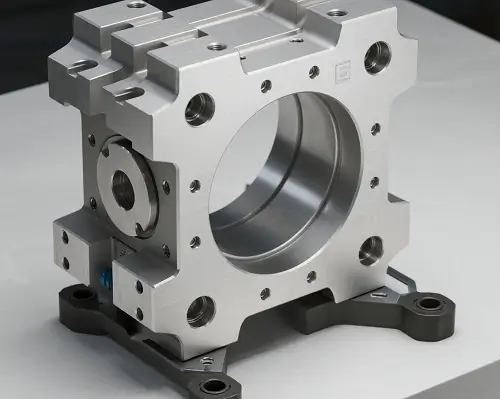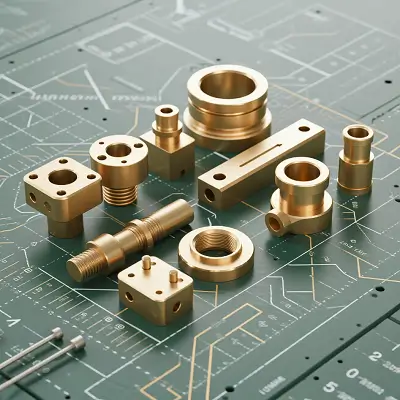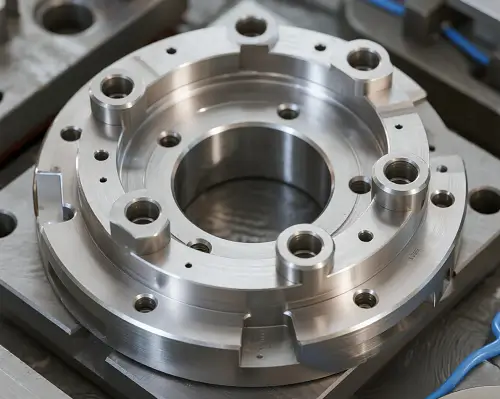Aluminum has established itself as a cornerstone in precision manufacturing. With a unique blend of low weight, strength, corrosion resistance, and affordability, aluminum has become the material of choice across aerospace, automotive, medical, consumer electronics, and robotics. When paired with CNC machining, aluminum provides unmatched versatility by enabling engineers to create prototypes, refine designs, and scale into production using the same base material. Aluminum CNC machining is not only about machinability or softness; effective use requires selecting the right alloy, designing for manufacturability, and setting realistic expectations for tolerance, surface finish, and cost from prototype through production.As one of the most commonly used CNC machining materials, aluminum offers an excellent balance of strength, machinability, and cost.

Why Aluminum is Ideal for CNC Machining
Aluminum alloys stand out in CNC machining because aluminum combines machinability with performance. Low cutting forces allow high spindle speeds and aggressive toolpaths, which reduce cycle times and minimize tool wear. Dimensional stability ensures that even complex geometries maintain accuracy, making aluminum a suitable choice for demanding assemblies. Aluminum also offers inherent corrosion resistance and excellent thermal and electrical conductivity, making aluminum valuable for housings, heat sinks, and enclosures that must withstand functional and environmental stresses. In addition, aluminum remains cost-effective for both one-off prototypes and low-to-mid volume runs, providing a practical alternative to steel, titanium, or stainless steel.
Popular Aluminum Grades in CNC Projects
The selection of aluminum alloy significantly affects machinability, strength, fatigue resistance, and corrosion performance.
| Grade | Characteristics | Common Uses |
|---|---|---|
| 6061-T6 | Excellent machinability, anodizes well, balanced strength | Automotive housings, brackets, consumer products |
| 7075 | High strength, lower corrosion resistance, harder to machine | Aerospace structural parts, defense components |
| 2024 | High fatigue resistance, good strength | Aircraft skins, riveted assemblies |
| 5083 | Exceptional corrosion resistance in marine settings | Ship components, pressure vessels |
6061-T6 remains the most versatile and economical option, widely used in general-purpose components. 7075 provides aerospace-grade strength but requires more careful machining due to hardness and reduced corrosion resistance. 2024 excels under cyclic loading, while 5083 is the first choice for marine and chemical environments. Material selection influences downstream processing such as anodizing, polishing, or bead blasting, as well as achievable tolerance levels.
Typical Applications of Aluminum CNC Machining
Aluminum serves across nearly every industry where weight reduction, thermal stability, or corrosion resistance is valued. In aerospace, 7075 aluminum enables high-strength mounting brackets, housings, and airframe ribs without compromising weight limits. Automotive manufacturers rely on 6061 and 7075 aluminum for electric vehicle battery trays, thermal management components, and lightweight interior structures. Consumer electronics benefit from machined aluminum enclosures that deliver both modern aesthetics and electromagnetic shielding, essential for laptops, tablets, and wearables. Medical industries choose aluminum for surgical instruments, diagnostic housings, and laboratory fixtures that require sterilization and dimensional consistency. Robotics and automation systems rely on aluminum frames and end-effectors that balance rigidity with reduced mass, ensuring fast and precise movement.
Design Guidelines for Machining Aluminum
Designing for aluminum CNC machining requires attention to geometric stability and manufacturability. Deep cavities increase chatter and reduce precision, so minimizing cavity depth improves results. Consistent wall thickness avoids warping caused by uneven material removal, and filleted inside corners reduce both tool stress and component stress concentration. Engineers generally avoid walls thinner than 1 mm, holes smaller than 1.5 times the cutting tool diameter, or sharp internal corners that demand specialized cutters. Surface treatments such as anodizing or bead blasting require uniform wall thickness and easy-to-access surfaces for consistent finishing. By applying these guidelines, aluminum parts achieve better dimensional accuracy, improved surface integrity, and lower production costs.
Machining Parameters and Process Tips
High spindle speeds, often between 10,000 and 20,000 rpm, maximize aluminum’s machinability, while aggressive feed rates shorten cycle times without sacrificing accuracy. Carbide end mills with polished flutes prevent chip welding and extend tool life during aluminum machining. Aluminum’s high thermal conductivity dissipates cutting heat quickly, but thermal expansion can distort dimensions if process control is lacking. Continuous coolant supply maintains thermal stability and clears chips efficiently. Roughing passes benefit from adaptive toolpaths to maintain consistent engagement, while finishing passes use lighter depths of cut to ensure high-quality surfaces. The correct balance of spindle speed, feed rate, and cutting strategy allows aluminum machining to deliver both productivity and accuracy.
Tolerances and Surface Finish Options
Aluminum CNC machining enables extremely tight tolerances that meet high-precision requirements. At JeekRapid, tolerances of ±0.005 mm are achievable on critical features, while ±0.01 mm is standard for general features. This precision makes aluminum appropriate for assemblies in aerospace, automotive, and medical industries where fit and alignment are critical.
Surface finish options expand the use cases for aluminum components. As-machined surfaces with Ra ~3.2 µm work for functional prototypes and hidden components. Bead blasting followed by anodizing produces matte finishes with corrosion resistance suitable for consumer or industrial applications. Polished or brushed aluminum achieves decorative appeal for electronics or visible components.
| Finish | Typical Roughness (Ra) | Application |
|---|---|---|
| As-machined | 3.2 µm | Prototypes, internal components |
| Bead blasted + anodized | 1.6–2.0 µm | Consumer products, housings |
| Polished or brushed | <1.0 µm | Decorative, aesthetic applications |
Cost Factors in Aluminum CNC Machining
The cost of aluminum CNC machining is determined by material choice, part geometry, tolerance demands, production volume, and surface finishing. 6061 aluminum offers the lowest overall cost due to machinability and anodizing compatibility, whereas 7075 commands higher prices because of raw material costs and tool wear. Designs with thin walls, undercuts, or complex cavities increase machining time, while straightforward geometries are faster and less expensive. Tighter tolerances such as ±0.005 mm require slower toolpaths, additional setups, and detailed inspections, raising overall cost. Production volume also changes the equation: one-off prototypes appear expensive because programming and setup cannot be distributed, but small or medium batches achieve more favorable per-part pricing. Post-processing adds further expense, with anodizing, bead blasting, or polishing contributing an additional 10–30 percent of total cost. For example, a single 6061 prototype housing may exceed $120 per part, while a batch of 200 anodized enclosures might drop to $40–60 each.
| Part Type | Alloy | Quantity | Finish | Approx. Cost per Part* |
|---|---|---|---|---|
| Prototype housing | 6061-T6 | 1 | As-machined | $120–180 |
| Structural bracket | 7075 | 50 | Anodized | $60–90 |
| Medical enclosure | 6061-T6 | 200 | Bead blasted + anodized | $40–60 |
*Cost varies with geometry, supplier, and region.
From Prototype to Production: Scaling Up with Confidence
CNC machining of aluminum offers a unique advantage by enabling seamless transitions from prototype to scaled production. Engineers start with a prototype to evaluate form, fit, and function, then move into bridge production to refine tolerances and finishes. Once validated, production batches can scale to hundreds of units with the same process, avoiding the cost of dedicated tooling. For specialized industries and custom products, aluminum CNC machining often remains the primary production method due to flexibility and precision. This scalability allows companies to launch products faster and with greater confidence in performance.
CNC Aluminum vs Other Materials
Aluminum provides a balanced alternative compared with steel, plastics, and titanium. Steel offers higher tensile strength, but aluminum’s density of 2.7 g/cm³ is only one-third of steel, giving aluminum a clear weight advantage for aerospace and mobility applications. 7075 aluminum approaches the strength of some steels while resisting corrosion more effectively than untreated steel. Plastics are inexpensive and easy to cut but lack structural integrity and dimensional stability under heat, making aluminum the better choice for load-bearing and thermally exposed parts. Titanium outperforms aluminum in strength-to-weight ratio and corrosion resistance, but titanium’s high cost and poor machinability restrict titanium to aerospace, medical implants, and defense. Aluminum strikes the middle ground—lighter than steel, stronger than plastics, and significantly more economical than titanium—explaining aluminum’s dominance across industries.
| Property | Aluminum | Steel | Plastic | Titanium |
|---|---|---|---|---|
| Density (g/cm³) | ~2.7 | ~7.8 | 0.9–1.5 | ~4.5 |
| Tensile Strength (MPa) | 200–570 | 250–1000+ | 40–80 | 600–1000+ |
| Machinability | Excellent | Moderate | Excellent | Poor |
| Corrosion Resistance | High | Variable | High | Very High |
| Relative Cost | $$ | $ | $ | $$$$ |
Why Work with JeekRapid for Aluminum CNC Machining
JeekRapid specializes in aluminum CNC machining with the capability to support projects from prototype through production. In-house equipment includes 3-, 4-, and 5-axis machining centers capable of handling complex geometries with speed and accuracy. ISO 9001-certified processes ensure consistent quality across all orders. JeekRapid offers design-for-manufacturability reviews, tolerance optimization, and material selection guidance tailored to each industry. Rapid turnaround times as short as three days and competitive pricing for low-to-mid volume runs make JeekRapid an ideal partner for companies developing new products. Whether the requirement is a single prototype for functional testing or a production batch ready for assembly, JeekRapid delivers reliable aluminum CNC machining with technical expertise. Upload your CAD file to request a free quotation today.
FAQ: Aluminum CNC Machining
Q: What is the best aluminum grade for CNC machining?
6061-T6 is the most widely used due to its balance of machinability, strength, and anodizing performance. For higher strength requirements, 7075 aluminum is preferred.
Q: What tolerances are achievable with aluminum CNC machining?
Precision machining of aluminum achieves ±0.005 mm for critical dimensions and ±0.01 mm for general features.
Q: Can aluminum CNC parts be anodized?
Yes. Alloys such as 6061 anodize particularly well, offering both corrosion protection and cosmetic finishes.
Q: Is aluminum suitable for both prototypes and production runs?
Yes. Aluminum offers machinability, availability, and scalability, making aluminum appropriate for both prototyping and low-to-mid volume production.
Q: How does aluminum compare with steel, plastic, and titanium?
Aluminum is lighter than steel, stronger than most plastics, and far easier and cheaper to machine than titanium. This balance makes aluminum a versatile choice across industries.
Q: What is the typical lead time for CNC aluminum parts?
At JeekRapid, standard lead times range from 3–5 business days depending on geometry and order volume.


